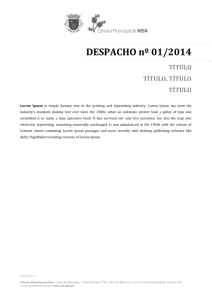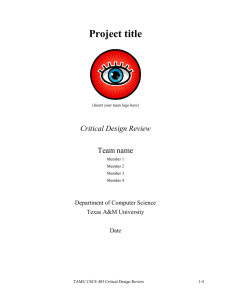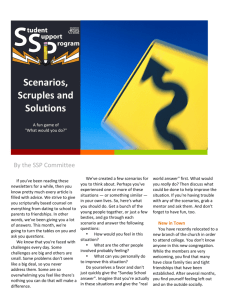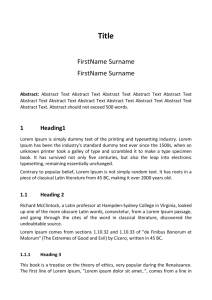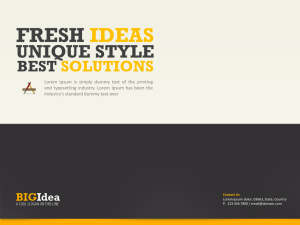Report template - CS Course Webpages
advertisement
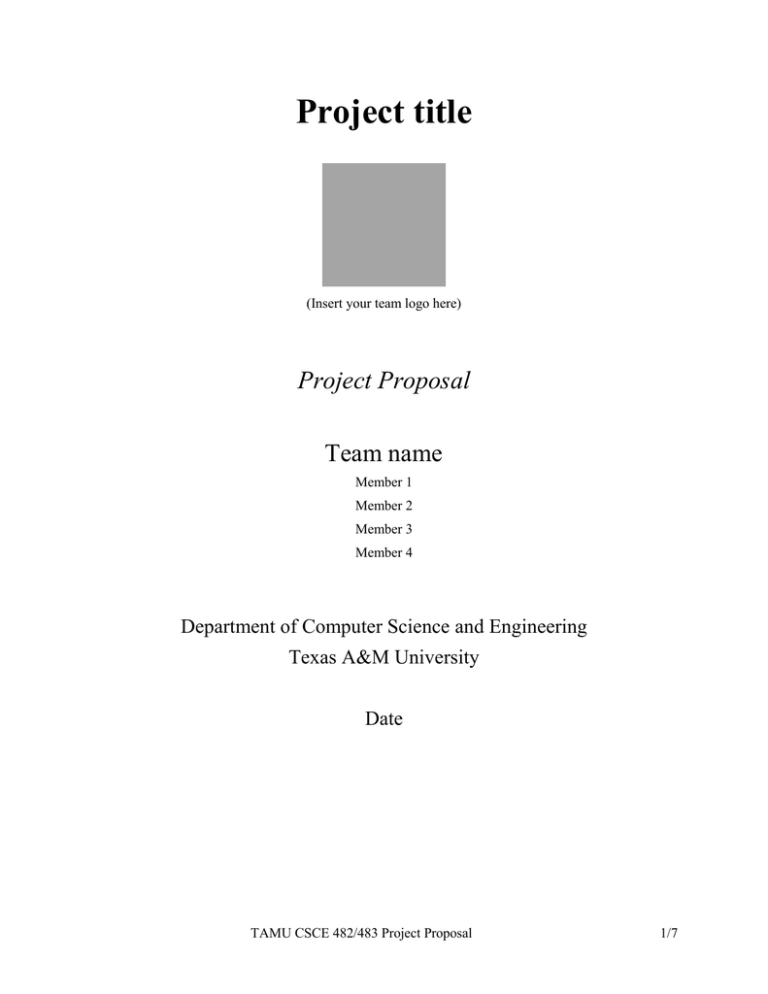
Project title (Insert your team logo here) Project Proposal Team name Member 1 Member 2 Member 3 Member 4 Department of Computer Science and Engineering Texas A&M University Date TAMU CSCE 482/483 Project Proposal 1/7 Table of Contents 1 Problem statement (30 points) .............................................................................................................. 3 1.1 Need (5 points) .............................................................................................................................. 3 1.2 Objective (5 points)....................................................................................................................... 3 1.3 Marketing requirements (5 points) ................................................................................................ 3 1.4 Objective tree (5 points)................................................................................................................ 3 1.5 Requirements specification (10 points)......................................................................................... 3 2 Background and technology survey (15 points).................................................................................... 3 3 Proposed work (40 points) .................................................................................................................... 3 3.1 Concept generation (10 points) ..................................................................................................... 3 3.2 Concept evaluation (5 points) ....................................................................................................... 3 3.3 Functional design (15 points)........................................................................................................ 4 3.3.1 Level 0 diagram .................................................................................................................... 4 3.3.2 Level 1 diagram .................................................................................................................... 4 3.4 4 Acceptance testing (10 points) ...................................................................................................... 4 Project management (13 points) ........................................................................................................... 5 4.1 Work breakdown structure (6 points) ........................................................................................... 5 4.1.1 Timeline ................................................................................................................................ 5 4.2 Costs (2 points) ............................................................................................................................. 6 4.3 Software engineering (2 points) .................................................................................................... 6 4.4 Team management (3 points)........................................................................................................ 6 4.4.1 Decision making guidelines .................................................................................................. 6 4.4.2 Meeting guidelines ................................................................................................................ 6 4.4.3 Conflict resolution................................................................................................................. 6 4.4.4 Team roles ............................................................................................................................. 6 5 References cited (2 points) .................................................................................................................... 7 6 Typical mistakes that cost you points ................................................................................................... 7 TAMU CSCE 482/483 Project Proposal 2/7 1 1.1 PROBLEM STATEMENT (30 POINTS) Need (5 points) Use the final version from your Problem Statement document. 1.2 Objective (5 points) Use the final version from your Problem Statement document. 1.3 Marketing requirements (5 points) Use the final version from your Problem Statement document. 1.4 Objective tree (5 points) Use the final version from your Problem Statement document. 1.5 Requirements specification (10 points) Use the final version from your Requirements Specification document. 2 BACKGROUND AND TECHNOLOGY SURVEY (15 POINTS) This section is similar to the one on the Problem Statement document, but should be expanded to include at least ten (10) references of related work. References may include scientific articles, products, or related projects. 3 3.1 PROPOSED WORK (40 POINTS) Concept generation (10 points) In this section you describe multiple design concepts that may be used to achieve your stated objective. As such, these concepts should follow from your stated objective; for instance, if your objective is to track human activity using smartphones, using a stationary sensor is not a valid concept. Likewise, implementation details (e.g., programming language) or cosmetics (e.g., color, feel) are generally not valid concepts, unless you can argue that they are critical to the success of your concept. This section should include at least five (5) alternative concepts, and it should describe the process you followed to generate these concepts (e.g., brainwriting, concept table, nominal group technique, or some other concept generation process). Each alternative concept should describe the complete system, not specific modules within the system. 3.2 Concept evaluation (5 points) In this section you evaluate the alternative concepts using the Analytical Hierarchy Process described in chapter 4 and appendix B of the textbook. You will need to (1) determine the selection criteria, (2) determine the criteria weighting, (3) rate the alternative concepts relative to the criteria, (4) compute scores for these alternatives, and (5) review your final decision. The section should include the AHP decision matrix in Table 1. Table 1. Decision matrix for the Analytical Hierarchy Process Concept 1 Criteria 1 Concept 2 Concept 3 … Concept N Weight 1 TAMU CSCE 482/483 Project Proposal 3/7 Criteria 2 ⋮ Criteria M 3.3 Weight 2 ⋮ Weight M Functional design (15 points) In this section you provide an initial description of the concept you have selected. The description should include (1) a Level-0 diagram, (2) a Level-1 diagram, and (3) for each diagram the accompanying text description in the body of the document. The diagrams may be in the form of functional decompositions or data flow, whichever is best suited for your project. When generating these diagrams, aim for elegance and visual simplicity; black-and-white line drawings with text (see Figure 1b) are generally preferable to pictures or clipart (see Figure 1a). As a recommendation, you can easily generate very effective diagrams with the tool Lucidchart. Please also describe the underlying principles in mathematics, physics, computer science and engineering that guide your overall design (or some aspects of the design), the specific technologies you plan to use (e.g., web/cloud services, mobile devices/apps, databases, HW/SW architectures, sensors, interfaces), and any existing libraries or platforms (e.g., open source libraries, standardized technologies such as jQuery and HTML 5) that will allow you to avoid having to implement low-level functionality. 3.3.1 Level 0 diagram Include your Level-0 diagram and associated text description. 3.3.2 Level 1 diagram Include your Level-1 diagram and text description. Tablet Tablet The internet User Server Speech recordings Clinician interface Tablet Speech processing engine Computer (a) Updated exercises (b) Figure 1. (a) A poor choice of a Level-0 diagram; first, the diagram is visually cluttered and the fonts are illegible; second, the diagram itself does not convey much information since most computer systems have a user, a computer, and the web. (b) A reasonable Level-1 diagram of a multi-tier remote delivery system for speech therapy. 3.4 Acceptance testing (10 points) Describe the conditions upon which the customer will accept the system. This should be specified in the form of a suite of test cases that ensure that all the engineering requirements are met. Each test case should be described in the form of Table 2. Highlighted fields must be specified in the proposal; the remaining fields would be entered at the time of testing (please remove the highlights when you submit your proposal.) TAMU CSCE 482/483 Project Proposal 4/7 Table 2. Template for acceptance test cases. Test writer: ??? Test case name ??? Test ID# Description ??? Type ??? ☐ white box ☐ black box Tester information: Name of tester Date Hardware version Time Action Expected result 1 ??? ??? 2 ??? ??? … ??? ??? Pass Fail N/A ??? Step Setup Comments Overall test result 4 PROJECT MANAGEMENT (13 POINTS) 4.1 Work breakdown structure (6 points) Provide a hierarchical breakdown of all the tasks and deliverables that need to be completed in order to accomplish the project objective. The work breakdown structure will be reported according to the format in Table 3; see section 10.1 in the textbook for an example. Please include text describing the contents of the table. Predecessors Resources People Duration (days) Deliverables/ checkpoints Description Activity ID Table 3. Example of a work breakdown structure 1 1.1 1.2 1.2.1 2 2.1 4.1.1 Timeline Include Gantt chart to illustrate the timeline for the work breakdown structure; see section 10.3 in the textbook for an example. Can you guess what’s wrong with the Gantt chart below? TAMU CSCE 482/483 Project Proposal 5/7 Figure 2. A really bad Gantt chart. First, the task decomposition is too coarse to be of much use. Second, it assumes that none of the tasks can be developed in parallel. 4.2 Costs (2 points) Include a tabulated list of costs for equipment, materials, and labor. Since this is a capstone project, estimate labor costs in worker-hours. 4.3 Software engineering (2 points) Describe the software engineering approach you intend to use (i.e., agile vs. waterfall) and discuss why you choose a particular methodology (e.g., Scrum, TDD, Kanban). 4.4 Team management (3 points) 4.4.1 Decision making guidelines Indicate what techniques you will use to make decisions and when you will apply such techniques 4.4.2 Meeting guidelines Describe how meetings will be run, how often, and what the expectations are for team members 4.4.3 Conflict resolution Identify how the team will resolve conflicts whenever they occur. 4.4.4 Team roles For each team member, describe the administrative roles (e.g., leader, scribe, procurement, project manager) and technical responsibilities (e.g., hardware, interface, software, testing, etc.). Summarize them in the form of a task matrix –see Table 4. Your task matrix should conform to the following guidelines: - Multiple people may work on a particular task, but only one person can have primary responsibility for the task (i.e., there should be a single ‘1’ for each row in the task matrix). Each person must be primary responsible for at least one task (i.e., each column in the task matrix must have at least a ‘1’). Each person must have technical responsibilities. For instance, it would not be acceptable for one person to handle purchasing and documentation but not perform any development or testing. Table 4. Task matrix for technical responsibilities. Task 1 2 3 4 5 6 7 Description Lorem ipsum Lorem ipsum Lorem ipsum Lorem ipsum Lorem ipsum Lorem ipsum Lorem ipsum Pete 1 2 1 Team members Ann Mike TAMU CSCE 482/483 Project Proposal 1 2 2 Sue 2 2 1 1 1 6/7 8 5 Lorem ipsum X REFERENCES CITED (2 POINTS) Here you acknowledge all the documents that you used as references throughout the text. Please follow the APA citation standard for references, as described in the Problem Statement template. 6 TYPICAL MISTAKES THAT COST YOU POINTS 1) 2) 3) 4) Not following the formatting of the template Not including text in the body of the document to describe the content of figures and tables Engineering requirements are either very similar to marketing requirements, or unrelated to them Background section too disorganized, no subsections describing the various bodies of knowledge related to the project 5) Concepts generated not being described in detail 6) Concept evaluation not being described in detail. What are the different criteria, how were they selected, how were they weighted? 7) Work breakdown structure or task matrix shows multiple people as primary for each task TAMU CSCE 482/483 Project Proposal 7/7
